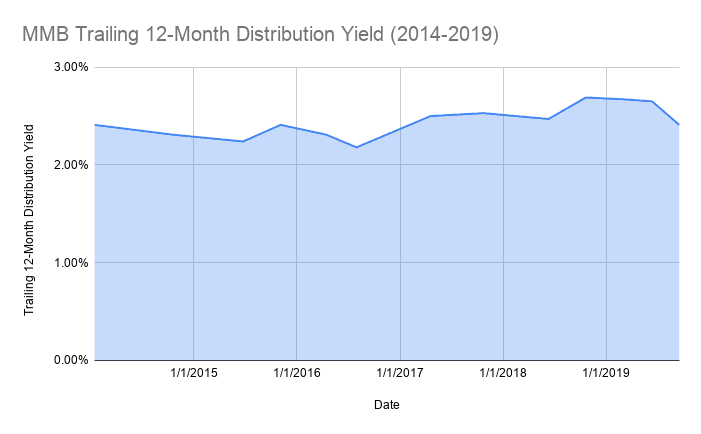 One of the biggest problems in retirement planning is making sure a pile of money lasts throughout your retirement. I have read hundreds of articles about this topic, and there is no single solution. My imperfect (!) solution is to first build a portfolio designed for total return using assets that have enough faith in to hold through an extended downturn. I do not look for the highest income – no specialized ETFs, no high-dividend-only stocks, no high-yield bonds.
One of the biggest problems in retirement planning is making sure a pile of money lasts throughout your retirement. I have read hundreds of articles about this topic, and there is no single solution. My imperfect (!) solution is to first build a portfolio designed for total return using assets that have enough faith in to hold through an extended downturn. I do not look for the highest income – no specialized ETFs, no high-dividend-only stocks, no high-yield bonds.
Then, only after that do I check out how much it distributes in dividends and interest. Dividends are the portion of profits that businesses have decided they don’t need to reinvest into their business. The analogy I fall back on is owning a rental property. If you are reliably getting rent checks that increase with inflation, you can sit back calmly and ignore what the house might sell for on the open market.
I track the “TTM Yield” or “12-Month Yield” from Morningstar, which the sum of a fund’s total trailing 12-month interest and dividend payments divided by the last month’s ending share price (NAV) plus any capital gains distributed over the same period. I prefer this measure because it is based on historical distributions and not a forecast. Below is a very close approximation of my investment portfolio (2/3rd stocks and 1/3rd bonds).
| Asset Class / Fund | % of Portfolio | Trailing 12-Month Yield (Taken 9/17/19) | Yield Contribution |
| US Total Stock Vanguard Total Stock Market Fund (VTI, VTSAX) |
25% | 1.85% | 0.46% |
| US Small Value Vanguard Small-Cap Value ETF (VBR) |
5% | 2.35% | 0.12% |
| International Total Stock Vanguard Total International Stock Market Fund (VXUS, VTIAX) |
25% | 3.05% | 0.76% |
| Emerging Markets Vanguard Emerging Markets ETF (VWO) |
5% | 2.71% | 0.14% |
| US Real Estate Vanguard REIT Index Fund (VNQ, VGSLX) |
6% | 3.29% | 0.20% |
| Intermediate-Term High Quality Bonds Vanguard Intermediate-Term Treasury ETF (VGIT) |
17% | 2.20% | 0.37% |
| Inflation-Linked Treasury Bonds Vanguard Short-Term Inflation-Protected Securities ETF (VTIP) |
17% | 2.12% | 0.36% |
| Totals | 100% | 2.41% |
Here is a chart showing how this 12-month trailing income rate has varied over the last five years.

One of the things I like about using this number is that when stock prices drop, this percentage metric usually goes up – which makes me feel better in a gloomy market. When stock prices go up, this percentage metric usually goes down, which keeps me from getting too euphoric. I see it as a very conservative, valuation-based withdrawal rate metric due to our very long retirement horizon of 40+ years.
In practical terms, I let all of my dividends and interest accumulate without automatic reinvestment. I treat this money as my “paycheck”. Then, as with my real paycheck, I can choose to either spend it or reinvest in more stocks and bonds. This number does not dictate how much we actually spend every year, but it gives me an idea of how comfortable I am with our withdrawal rate.
I am a proponent of aggressively saving, and then using the potential income that brings to improve your daily lifestyle. Instead of sitting on a beach, we used our nest egg to allow us to work less hours in a more flexible manner as parents of young children. Others may use it to start a new business, travel around the world, do charity or volunteer work, and so on. The income from our portfolio lets us “work less and live more” now as I now fear running out of time more than running out of money.
(If you’re still in the accumulation phase, you don’t really need to worry about this number. I believe a 3% withdrawal rate remains a reasonable target for something retiring young (before age 50) and a 4% withdrawal rate is a reasonable target for one retiring at a more traditional age (closer to 65). If you are young, instead focus on your earning potential via better career moves, investing in your skill set, and/or look for entrepreneurial opportunities where you own equity in a business.)
 The Best Credit Card Bonus Offers – 2025
The Best Credit Card Bonus Offers – 2025 Big List of Free Stocks from Brokerage Apps
Big List of Free Stocks from Brokerage Apps Best Interest Rates on Cash - 2025
Best Interest Rates on Cash - 2025 Free Credit Scores x 3 + Free Credit Monitoring
Free Credit Scores x 3 + Free Credit Monitoring Best No Fee 0% APR Balance Transfer Offers
Best No Fee 0% APR Balance Transfer Offers Little-Known Cellular Data Plans That Can Save Big Money
Little-Known Cellular Data Plans That Can Save Big Money How To Haggle Your Cable or Direct TV Bill
How To Haggle Your Cable or Direct TV Bill Big List of Free Consumer Data Reports (Credit, Rent, Work)
Big List of Free Consumer Data Reports (Credit, Rent, Work)
It’s such a simple question its’ hard to believe that it takes much of any thought at all. Instead of trying to drive your income to match your expenses, you match your expenses to your income and perhaps subtract an additional 5-10% for vacations or unexpected events.
Medicare plus Supplemental plan F mean absolutely no medical bills other then prescription drugs. Live in a city that doesn’t require owning a car. And or become a resident of a no income tax state and your set assuming you’ve put away about $2million in today’s dollars.
Okay, so how much income a year can a person take from that $2,000,000 and have it last for the next 50 years? You don’t provide an actual number.
1) So by your measure of income, can you now afford to retire and pay for your own health insurance, etc?
2) At this point you, are you still working partially to cover your expenses? How do you plan to deal with the “excess” money in your portfolio? Just extra security or are you increasing your discretionary expenses as portfolio enables?
3) Just curious, does running this blog help with some retirement expenses? I know personally I have taken many of your referrals and hopefully others too!
No, we’re not at the point where dividend and interest income can solely cover all of our expenses without worry. That’s why we are still working part-time. Yes, this site earns income (thanks for reading and using my referrals). However, I do want to reach the point where nothing else is required but dividends and interest income, no part-time work, no blog income. Not there yet!
I’m looking at some of your yields and on this same blog page I’m seeing advertisements of bank accounts giving the same yield on deposits (therefore removing principle volatility). How do you think about a moving some of your money to bank deposits (up to FDIC insurance max) given your portfolio yields are starting to lag in comparison?
That wouldn’t make sense, as the dividend yield is just one part of investment. The growth of the portfolio matters tremendously.
If you mean why not buy a bank CD instead of the bond funds, that is a possibility and I do have a big chunk of money in bank CDs from credit unions. Above is a model portfolio that anyone can invest in, but yes you could certainly swap out part of the US treasuries and go with bank CDs. Sometimes one yields more than the other, and it’s not always easy to switch back and forth.
Jonathan, I would echo your last line wrt focusing on your earning potential via better career moves, investing in skill set, etc.
Personally I considered Human Capital to be my biggest asset because when I came to this country as an immigrant; that was my only asset besides $1000. After slightly over a decade I achieved Financial Freedom. A lot of PF blogs focus on frugality without emphasizing the income side of the equation.